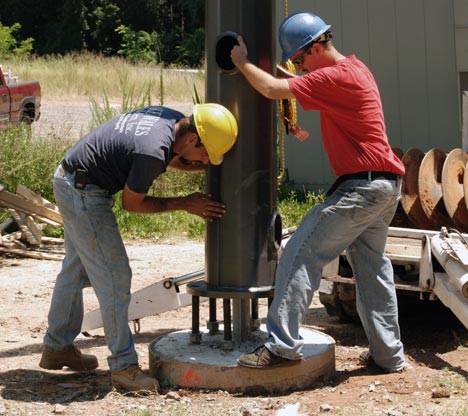Installation of Duke's Outdoor Warning System Underway

Perched near the top of a 40-foot steel pole, Greg Gilchrist adjusted his hard hat and began ratcheting bolts to secure an 800-pound honeycomb-shaped siren atop the pole.
About 20 minutes later, Gilchrist was safely on the ground, and Duke's first outdoor warning siren was up near the Sarah P. Duke Gardens off Anderson Street.

The first pole-mounted siren for Duke's outdoor warning system went up Tuesday across from the Sarah P. Duke Gardens. The beehive shaped piece of equipment is the modulator siren. A total of seven poles will be installed across campus.
"Duke has been working over the past year to enhance its emergency notification system, and the sirens are a significant addition that will warn people outdoors during life-threatening emergencies such as a tornado sighting, major chemical spill or an armed person on campus," said Aaron Graves, associate vice president for Campus Safety and Security. "In an emergency, people outdoors will hear warning tones and messages with rapid instruction to go inside, take shelter in a secure location or take some other action for safety."
As part of the DukeALERT mass notification system, seven pole-mounted sirens are going up this week in strategic locations on East, West and Central campuses, and near medical and research facilities. Many people indoors will not hear the warning system because it is designed for outdoors, where e-mail alerts or Web announcements are not effective.
"We can reach people in most buildings in other ways," Graves said. "Duke's approach is to build redundancy into rapid notification and offer a multi-pronged approach using a combination of voice, Web, e-mail and text messages to reach as many people as possible."
The siren poles, each weighing about 1,000 pounds, are being set in 15-to-18- foot concrete foundations. Warning tones and messages can travel up to one-half mile from each siren location, providing campus-wide coverage. Duke plans to test the outdoor system in mid-July.
"We used computerized acoustic models to determine the best locations to cover the campus," said Michael LaGoy, a senior analyst with Duke's Office of Information Technology, which is collaborating on the project with Facilities Management and Duke Police.
Duke's new siren system meets Federal Emergency Management Agency guidelines and was designed by Federal Signal Corp. in Illinois, which has provided systems for more than 25 colleges and universities, including UNC-Chapel Hill.
The Chronicle of Higher Education reported in March that many universities have added outdoor sirens to their emergency notification systems in the wake of the Virginia Tech shootings last spring.
Greg Gilchrist, vice president of West Shore Services, a Florida-based contractor that installs outdoor broadcast systems at universities, nuclear plants and military bases, is overseeing Duke's installation. He said similar systems have proven effective on other campuses.
"That big beehive is a modulator with speakers inside," he said. "They really put out the sound."